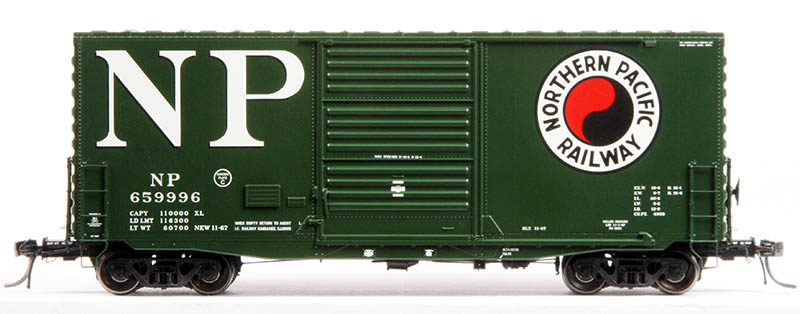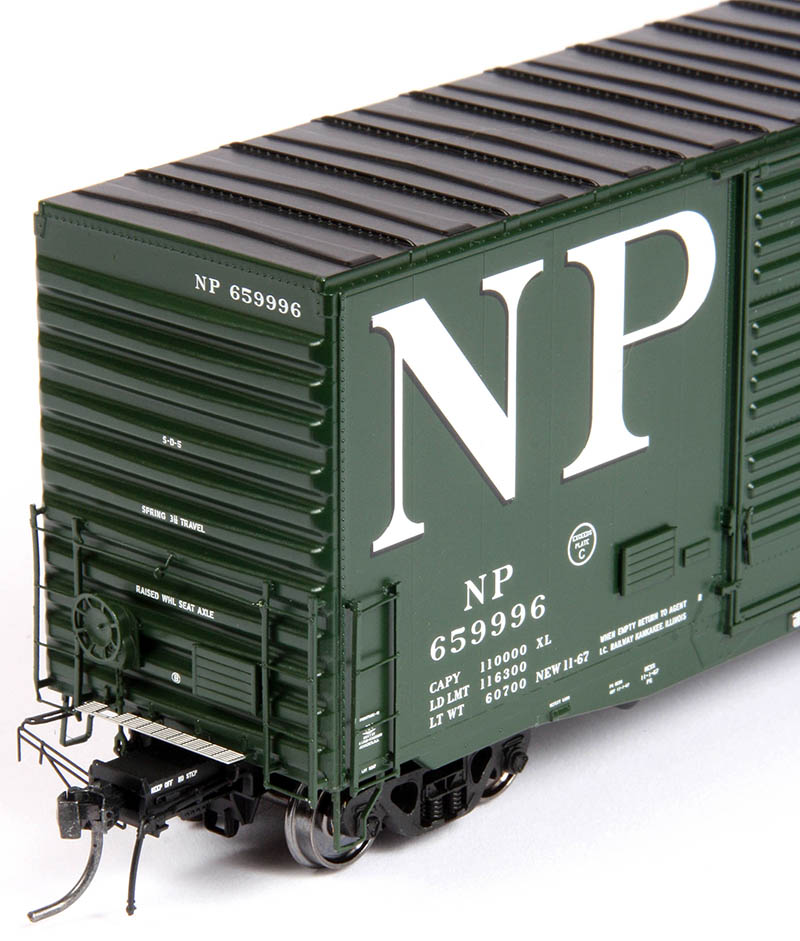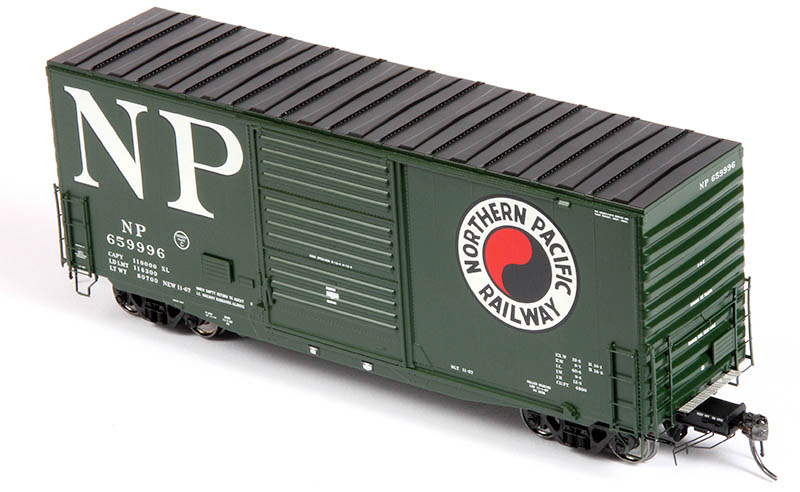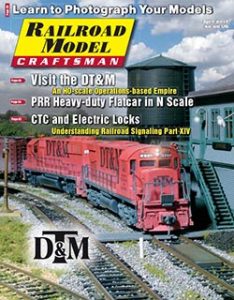 Review by David Otte/Photos by the author
Review by David Otte/Photos by the author
While I’ve now lost count of its numerous projects over the past decade, Tangent Scale Models has been a prolific producer of HO-scale freight cars that exhibit incredible museum-like quality details and its latest boxcar offering is no different—the Pullman-Standard PS-1 Mini-Hy Cube. Available factory direct and through select dealers, these popular prototypes from the late 1960s, especially designed for railroad’s that serviced appliance manufacturers, come in eight different flavors, each in multiple road numbers: Burlington Northern, Chicago, Burlington & Quincy (with and without door stripe); Denver & Rio Grande Western; Illinois Central; The Milwaukee Road (“DF2” and “DFB” schemes); and Northern Pacific, at a suggested retail price of $44.95 each, as well as an undecorated kit for $37.95.
By the 1960s, the railroads were already in heavy competition with the trucking industry in the hauling of a wide range of commercial commodities. As such, railroads made every effort to provide the best service possible to their on-line customers including the use of industry-specific freight cars. In particular, the appliance industry required more efficient boxcars in which to ship their refrigerators, washers, and stoves than the standard 40-foot cars of the day could offer. Pullman- Standard answered this call for a tailored boxcar, which it referred to in advertising as the “Mini-Hy Cube.” This design maintained the common 40-foot, 6-inch interior length of the company’s PS-1 design boxcar, but increased the inside width to 9-feet, 6-inches and height to 12-feet, 9-inches. This extra vertical capacity allowed products such as refrigerators and hot water heaters to be double stacked and shorter appliances to be stacked three high. This arrangement provided the new car with a 4,900-cubic-foot capacity.

As might be expected with a specialized car such as the Mini-Hy Cube, Pullman-Standard only built 122 of these boxcars, which were delivered to five different railroads in 1967 and 1968. Chicago, Burlington & Quincy received 50 Hy Cubes, Denver & Rio Grande Western 11, Illinois Central ordered 30, The Milwaukee Road purchased 25, and Northern Pacific owned only six of the PS-1 boxcars. Similar 40-foot length dedicated appliance cars, generically referred to as “baby Hi-Cubes” were also produced by other car builders too. For example, Santa Fe owned cars of comparable dimensions built by Transco in 1967 and Union Pacific’s own Omaha Shops constructed 66 hi-cube boxcars, classed as BF-50-4, also in 1967.
Regardless of their origin, most of these cars were assigned to other railroads, however, as the appliance factories they served were off their own right-of-way. The Evansville, Ind., based Whirlpool refrigerator factory on the New York Central was a destination for some of the hi-cubes, while Whirlpool’s Marion, Ohio, washer and dryer factory on the Erie Lackawanna was home for a number of Santa Fe and Rio Grande appliance cars. Finally, a quantity of the CB&Q’s PS-1 boxcars was assigned to the Admiral refrigerator plant at Galesburg, Ill.
Furthermore, a majority of these cars were outfitted with load restraining devices and cushioned underframes. Santa Fe and Rio Grande denoted these cars with a “DF” on the car sides signifying damage-free load restraining mechanisms, while the CB&Q indicated the inclusion of these devices in its cars by adding a white diagonal stripe to the doors. Typical equipment included Evans belt rails and Equipco or Transco load dividers. Nonetheless, production certainly did not last long for these cars as newer larger boxcar designs began to be accepted. By the 1980s, few of the original PS-1 Mini-Hy Cubes were still in revenue service with most ending up in maintenance-of-way duty or in the scrap line

As 1:87 scale modelers, we have already experienced some of the other 40- foot baby Hi-Cube appliance boxcar prototypes over the years via a number of manufacturers, but this Tangent release is the first ready-to-run offering of the Pullman-Standard type to grace HO rails and especially welcomed with its high level of detail. Simmons-Boardman’s 1974 Car and Locomotive Cyclopedia provided excellent photos and car diagrams of the PS-1 Mini-Hy Cube with which I compared Railroad Model Craftsman’s sample. Consistent with the company’s past offerings, I found the Tangent boxcar to be quite precise in every measurement I checked. The original car data shows 29 feet 6 inches between the truck centers, 40-feet, 8-1/4-inch length over the end sills, and an outside width of 10 feet, 1-1/16-inch. The 5-39/64-inch long (over the delicate appearing end sills) miniature car matched these dimensions perfectly.
The tooling created to form the injection-molded one-piece boxcar shell displayed Tangent’s usual craftsmanship as well. This is evident in the model capturing the correct profile of the various ribs, panels, weld seams, and rivet heads making up the all-steel construction of the prototype as molded-in features. These important characteristics include: the roof with its raised “bow-tie” stamped pattern and very subtle peak; the 12 welded panels making up the side walls; the L-shaped angle brackets under the lower door guide and the riveted- on doorstop; the welded-on lower door opening gusset plates, which also contain various reinforcing rivet detail too; the four panel fabricated 10-foot wide door with the three upper sections, which were riveted together, containing the proper four ribs each and a narrow flat section added at the bottom; and, likewise, the Mini-Hy Cube’s unique 3-4- 4 ribbed pattern ends with an additional flat section at the top. And just like the real deal, a line of fine rivets populate the edges where the ends, sidewalls, and roof were joined together. In fact, just to be completely thorough, I noted that there was a total of 51 corner post rivets displayed on the HO-scale rendering, which matched that of the prototype exactly!
Of course, there are plenty of separately applied details to dote over as well. This category of the Tangent rendering includes two short, four rung ladders on each side and end; delicate appearing, but durable stirrup steps; tack boards; wire handholds on the car ends; see-through photo-etched coupler crossover platforms; the appropriate style of trombone type coupler cut levers; and a brake wheel with housing on the B end of the car — complete with chain and linkage to connect it to the miniature bell crank situated below the car end.

On its underside is even more eye candy for the freight car detail junkie. An add-on center sill representative of the cushioned design found on the prototype is present along with the underframe’s associated crossbearers molded-in the plastic floor. A complete AB style brake setup is present too with not only individual components making up the reservoir, control valve, cylinder, and retaining valve (the later detail correctly located on the left side of the car, I might add), but all the levers, slack adjuster, and piping as well. The brake system’s plumbing actually extends all the way out to the trainline air hoses with gladhands, which are situated along side well-executed extended draft gear boxes (yes, the later even includes the side key detail). Finally, the Mini-Hy Cube boxcar rides on the appropriate Barber S-2-A 70-ton roller bearing trucks complete with hand applied brake shoes and brake beams as well as blackened metal scale 33 inch diameter wheelsets.
RMC’s review sample arrived decorated for Northern Pacific. Car number 659996 was one of six cars in the 659994–659999 series delivered by Pullman-Standard in November 1967. The dedicated appliance service car was to be returned to the Illinois Central at Kankakee, Ill., as appropriately listed on the HO-scale model’s lower car sides. The review model, like its NP prototype, has been painted in “Lowery” dark green as used pretty much on all NP’s insulated boxcar fleet along with a black-painted roof and underbody. The Tangent replica’s consistently perfect paint finish is further enhanced by the sharp graphics that include a large eight-scale-foot diameter herald and billboard size “NP” lettering. All the tiny car data, printed in white, is opaque and fully readable under magnification too. Basically this car has a decoration job that lives up to Tangent’s now well-established quality.
Equipped with metal Kadee couplers and very free-rolling wheelsets, the 1:87 shorty appliance car will negotiate curves with a radius as tight as 18 inches with relative ease, so it will be a welcomed addition to any size layout. Furthermore, I checked the sample with a National Model Railroading Association’s Standards Gage and found both wheel gauge and coupler height to be within specs. The model’s weight, which has been aided by the addition of an internally installed steel plate, registers 4.4 ounces — only about a half-ounce over the NMRA’s recommended weight based on car length calculation.
Wow! Tangent has done it again — another masterpiece to add to your HO-scale rolling stock collection. The Mini-Hy Cubes, while limited to only a few original owners, do represent a very colorful and interesting prototype that saw service across many different U.S. railroads and, therefore, are perfectly suited for inclusion in almost any consist dated from late 1967 through the 1980s era.
Tangent Scale Models
P.O. Box 6514
Asheville, NC 28816
828-279-6106




